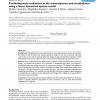3804 search results - page 616 / 761 » From Here to There |
BMCBI
2007
2007
Missing channels in two-colour microarray experiments: Combining single-channel and two-channel data
13 years 10 months ago
Background: There are mechanisms, notably ozone degradation, that can damage a single channel of two-channel microarray experiments. Resulting analyses therefore often choose betw...
BMCBI
2010
13 years 10 months ago
2010
Background: Transcription Factors (TFs) and microRNAs (miRNAs) are key players for gene expression regulation in higher eukaryotes. In the last years, a large amount of bioinforma...
BMCBI
2007
13 years 10 months ago
2007
Background: Deficiencies in microarray technology cause unwanted variation in the hybridization signal, obscuring the true measurements of intracellular transcript levels. Here we...
BMCBI
2007
13 years 10 months ago
2007
Background: Modelling of time series data should not be an approximation of input data profiles, but rather be able to detect and evaluate dynamical changes in the time series dat...
BMCBI
2010
13 years 10 months ago
2010
Background: Phylogenies capture the evolutionary ancestry linking extant species. Correlations and similarities among a set of species are mediated by and need to be understood in...


